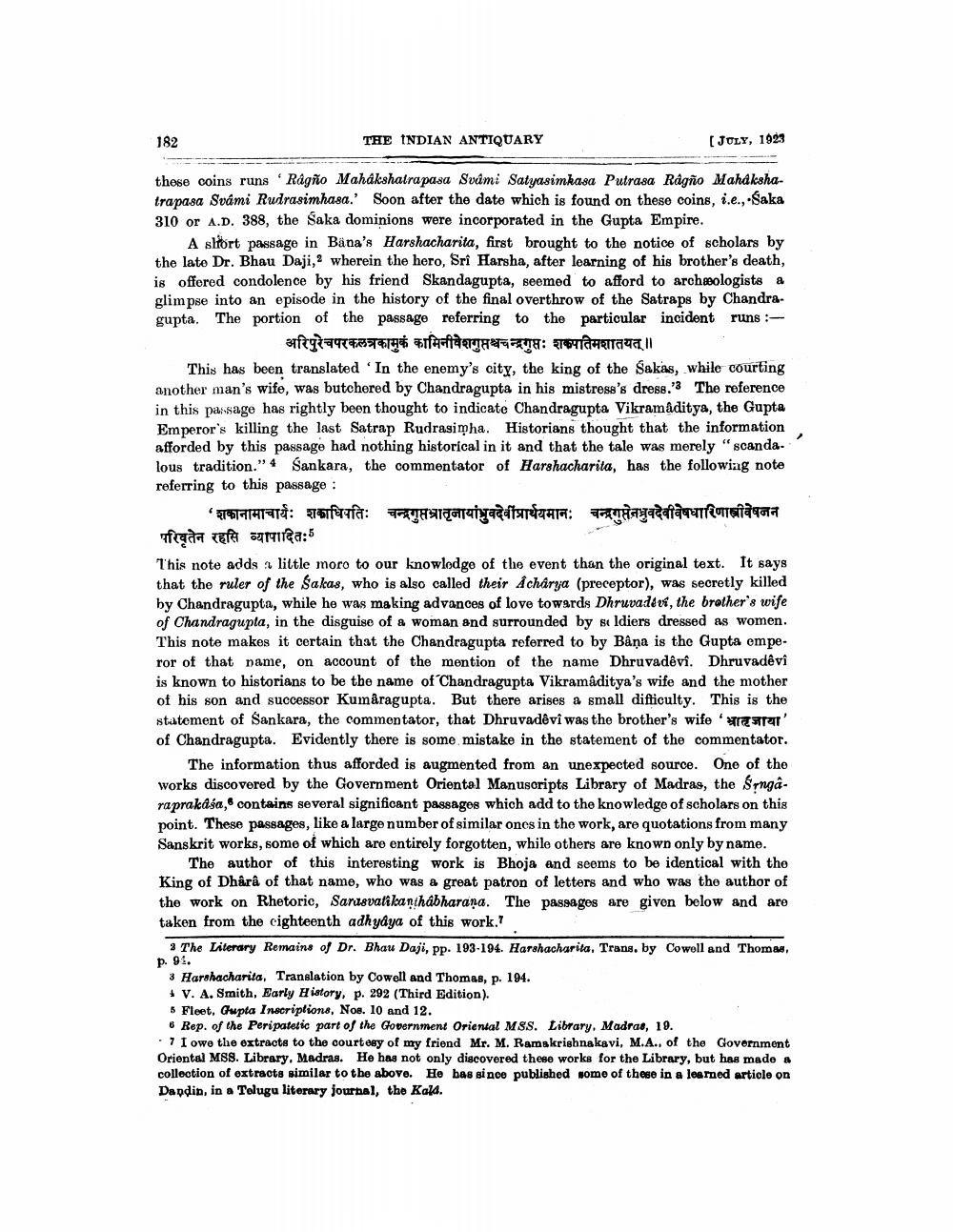________________
182
THE INDIAN ANTIQUARY
[JULY, 1923
these coins runs Ragño Mahakshatrapasa Svámi Satyasimkasa Putrasa Ragño Mahakshatrapasa Svámi Rudrasimhasa.' Soon after the date which is found on these coins, i.e., .Saka 310 or A.D. 388, the Saka dominions were incorporated in the Gupta Empire.
A sliort passage in Bana's Harshacharita, first brought to the notice of scholars by the late Dr. Bhau Daji, wherein the hero, Sri Harsha, after learning of his brother's death, is offered condolence by his friend Skandagupta, seemed to afford to archæologists a glimpse into an episode in the history of the final overthrow of the Satraps by Chandragupta. The portion of the passage referring to the particular incident runs :
अरिपुरेचपरकलत्रकामुकं कामिनीवेशगुप्तश्चचन्द्रगुप्तः शकपतिमशातयत् ॥ This has been translated 'In the enemy's city, the king of the Sakas, while courting another man's wife, was butchered by Chandragupta in his mistress's dress.'The reference in this pas sage has rightly been thought to indicate Chandragupta Vikramaditya, the Gupta Emperor's killing the last Satrap Rudrasimha. Historians thought that the information afforded by this passage had nothing historical in it and that the tale was merely "scandalous tradition." 4 Sankara, the commentator of Harshacharita, has the following note referring to this passage :
'शकानामाचार्यः शकाधिपतिः चन्द्रगुप्तभ्रातृनायांध्रुवदेवींप्रार्थयमानः चन्द्रगुप्तेनध्रुवदेवीवेषधारिणास्त्रीवेषनन परिवतेन रहसि व्यापादितः। This note adds a little moro to our knowledge of the event than the original text. It says that the ruler of the Sakas, who is also called their & charyja (preceptor), was secretly killed by Chandragupta, while he was making advances of love towards Dhruvadeur, the brother's wife of Chandragupta, in the disguise of a woman and surrounded by seldiers dressed as women. This note makes it certain that the Chandragupta referred to by Bana is the Gupta emperor of that name, on account of the mention of the name Dhruvadêvi. Dhruvadevi is known to historians to be the name of Chandragupta Vikramaditya's wife and the mother of his son and successor Kumaragupta. But there arises & small difficulty. This is the statement of Sankara, the commentator, that Dhruvadêvî was the brother's wife 'Can' of Chandragupta. Evidently there is some mistake in the statement of the commentator.
The information thus afforded is augmented from an unexpected source. One of the works discovered by the Government Oriental Manuscripts Library of Madras, the śrngaraprakasa, contains several significant passages which add to the knowledge of scholars on this point. These passages, like a large number of similar ones in the work, are quotations from many Sanskrit works, some of which are entirely forgotten, while others are known only by name.
The author of this interesting work is Bhoja and seems to be identical with the King of Dhârâ of that name, who was a great patron of letters and who was the author of the work on Rhetoric, Sarasvatikanthabharana. The passages are given below and are taken from the cighteenth adhyaya of this work.?
3 The Literary Remains of Dr. Bhau Daji, pp. 193-194. Harshacharita, Trans. by Cowell and Thomas, p. 9:. 3 Harshacharita, Translation by Cowell and Thomas, p. 194. # V. A. Smith, Early History, p. 292 (Third Edition). 5 Fleet, Gupta Inscriptions, Nos. 10 and 12. 8 Rep. of the Peripatetic part of the Government Oriental MSS. Library. Madras, 19. . 7 I owe the extracts to the courtesy of my friend Mr. M. Ramakrishnakavi, M.A.. of the Government Oriental MSS. Library. Madras. He has not only discovered these works for the Library, but has mado a collection of extracts similar to the above. He has since published some of those in a learned article on Dandin, in a Telugu literary journal, the Kala.




